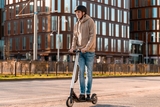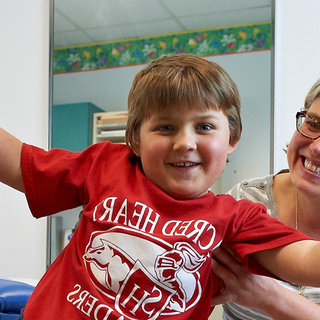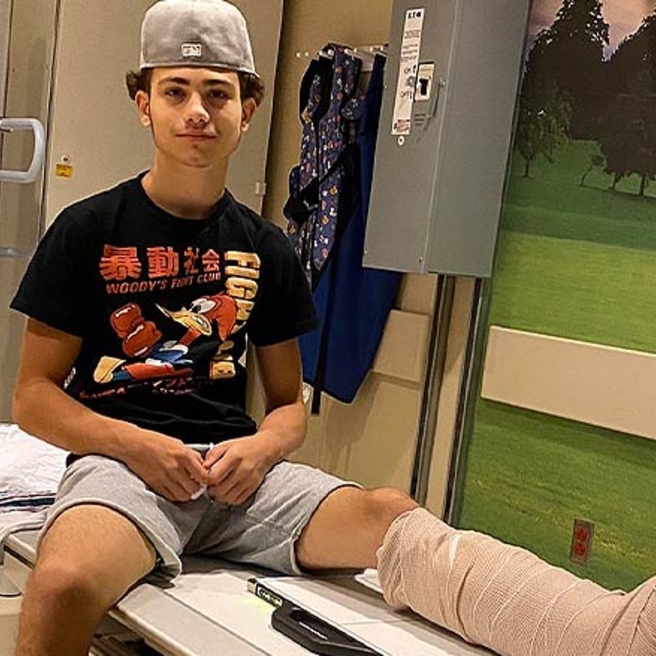
With electric scooters (e-scooters) being all the rage among teens, your family might already own one. And if not, it might only be a matter of time. But ideally, before your child ever steps foot on an electric scooter, there are some things you should know.
When it comes to e-scooters, there are some clear trends in common injuries and what causes them:
- E-scooter injuries among children and teenagers increased 71% from 2020 to 2021, and the most injured body part was the head.
- Nearly 67% of head injury patients were not wearing a helmet.
- Nearly 15% of all cases involved motor vehicles.
- Almost 10% of all cases involved obstacles such as uneven ground or potholes.
J. Todd Lawrence, MD, PhD, attending pediatric orthopaedic surgeon at Children’s Hospital of Philadelphia (CHOP), highlights the top tips and takeaways from that research, as presented by himself and co-author Radhika Gupta at the 2023 AAP National Conference and Exhibition.
Tips to prevent e-scooter injuries
Check for helmets!
First and foremost, your child’s head should be top priority, and helmets are the best way to protect it. It’s up to you as parents to make sure your child wears one before heading out. But helmet or not, your child is still vulnerable to outside forces.
Chart a safe path (with motorists in mind)
If possible, point your child to any available bike lanes nearby, where they can ride safely and separately from cars and other motorists. When that isn’t an option, try to identify where they can at least ride with minimal traffic and bumps in the road (literally).
Remember these key takeaways:
- Helmets are a must. Make sure your child is properly protected.
- Map out any available bike lanes or safe riding routes in advance.
- Keep eyes on the road (that goes for drivers and riders)!
According to Dr. Lawrence, “promoting helmet use among e-scooter riders and educating motor vehicle drivers on how to maintain safe distances” are things we should all keep in mind.
Featured in this article
Specialties & Programs
With electric scooters (e-scooters) being all the rage among teens, your family might already own one. And if not, it might only be a matter of time. But ideally, before your child ever steps foot on an electric scooter, there are some things you should know.
When it comes to e-scooters, there are some clear trends in common injuries and what causes them:
- E-scooter injuries among children and teenagers increased 71% from 2020 to 2021, and the most injured body part was the head.
- Nearly 67% of head injury patients were not wearing a helmet.
- Nearly 15% of all cases involved motor vehicles.
- Almost 10% of all cases involved obstacles such as uneven ground or potholes.
J. Todd Lawrence, MD, PhD, attending pediatric orthopaedic surgeon at Children’s Hospital of Philadelphia (CHOP), highlights the top tips and takeaways from that research, as presented by himself and co-author Radhika Gupta at the 2023 AAP National Conference and Exhibition.
Tips to prevent e-scooter injuries
Check for helmets!
First and foremost, your child’s head should be top priority, and helmets are the best way to protect it. It’s up to you as parents to make sure your child wears one before heading out. But helmet or not, your child is still vulnerable to outside forces.
Chart a safe path (with motorists in mind)
If possible, point your child to any available bike lanes nearby, where they can ride safely and separately from cars and other motorists. When that isn’t an option, try to identify where they can at least ride with minimal traffic and bumps in the road (literally).
Remember these key takeaways:
- Helmets are a must. Make sure your child is properly protected.
- Map out any available bike lanes or safe riding routes in advance.
- Keep eyes on the road (that goes for drivers and riders)!
According to Dr. Lawrence, “promoting helmet use among e-scooter riders and educating motor vehicle drivers on how to maintain safe distances” are things we should all keep in mind.
Recommended reading
Orthopedic Trauma Program

The Orthopedic Trauma Program cares for thousands of injured children each year.
Electric scooter injury

Following a serious e-scooter injury, Anthony’s summer break was about to be cut short.
Contact us
Orthopedic Center